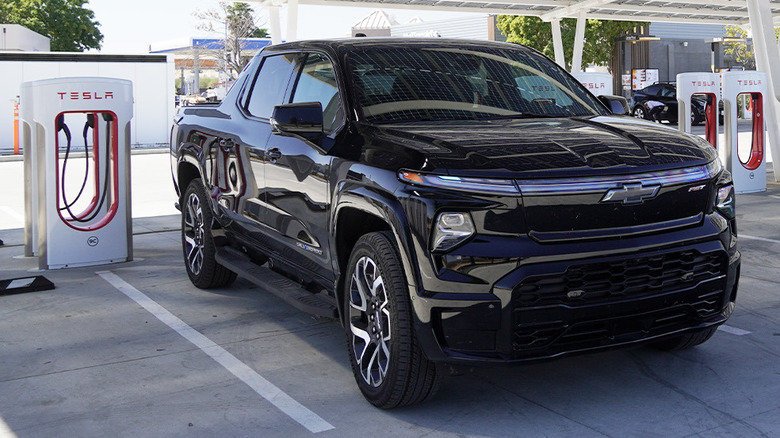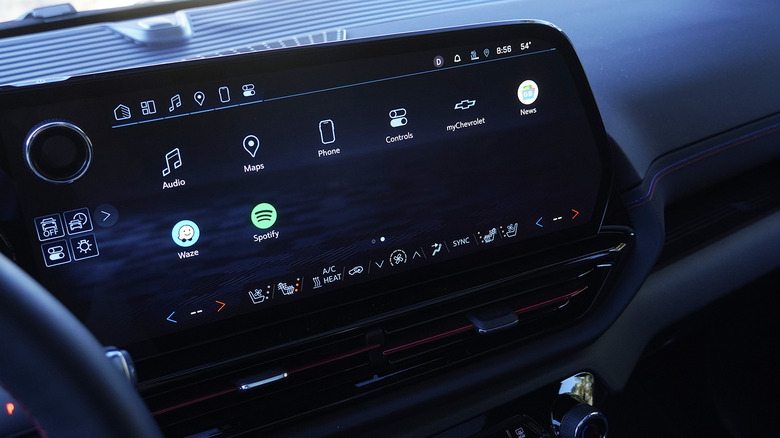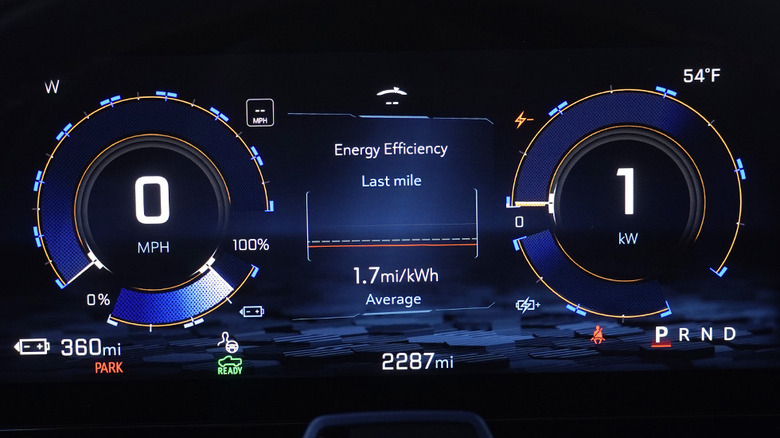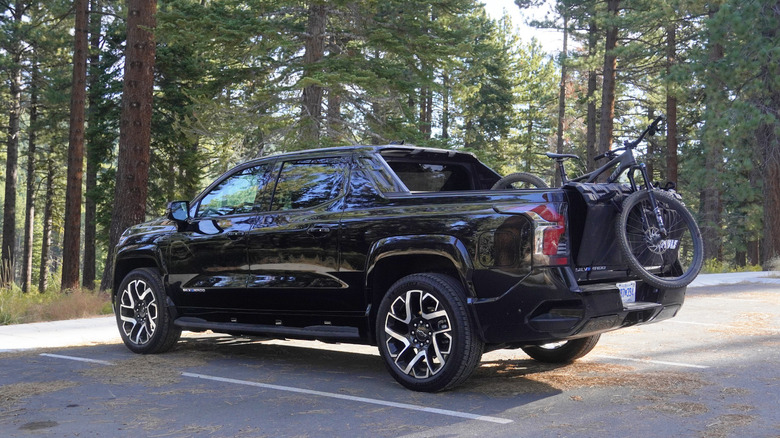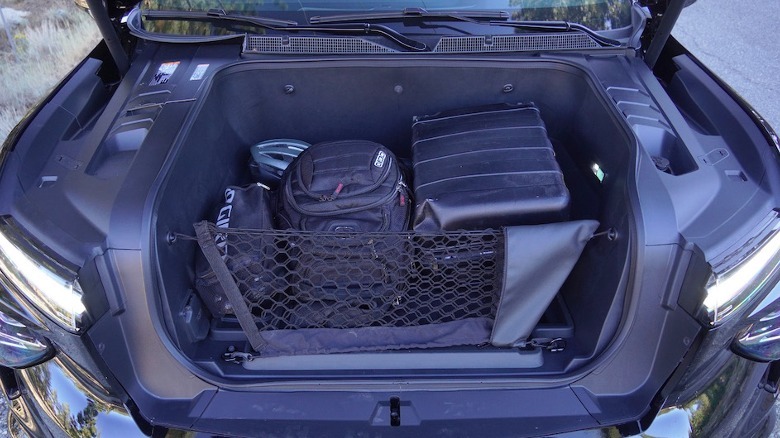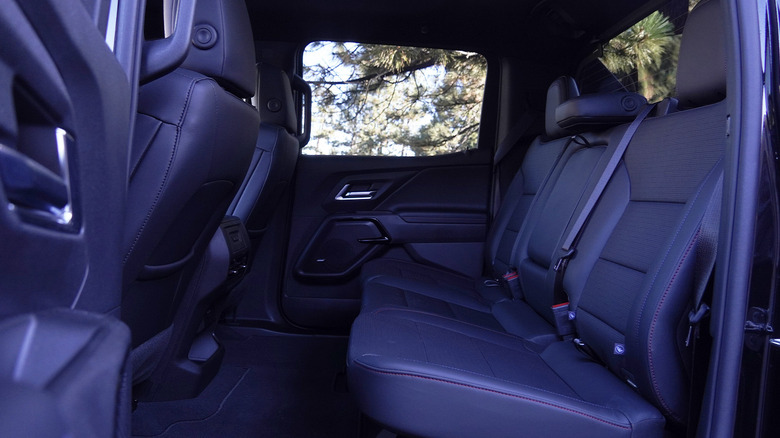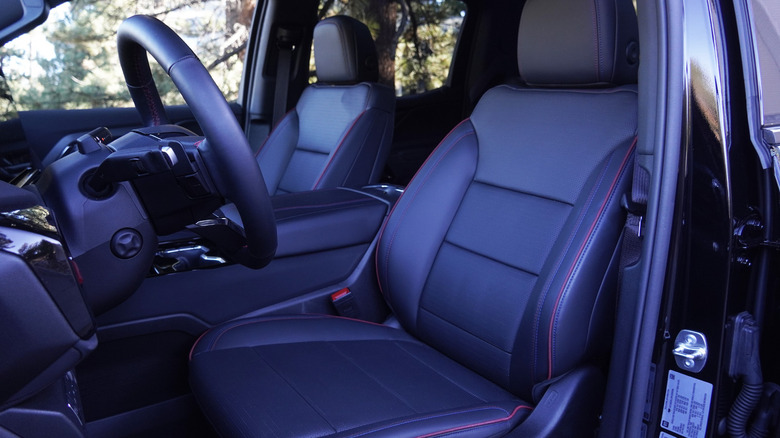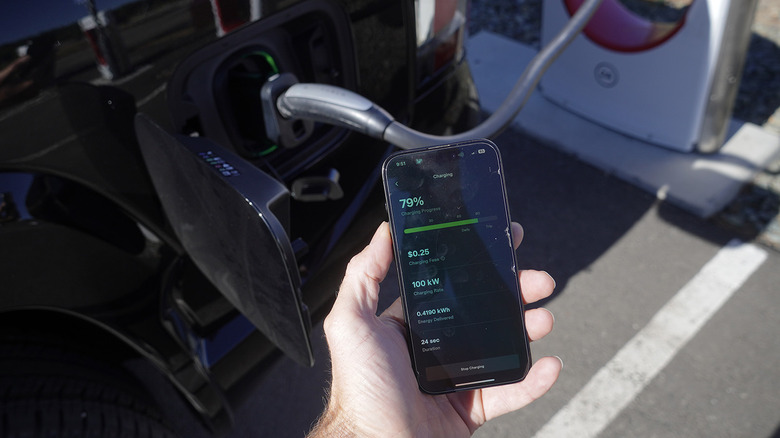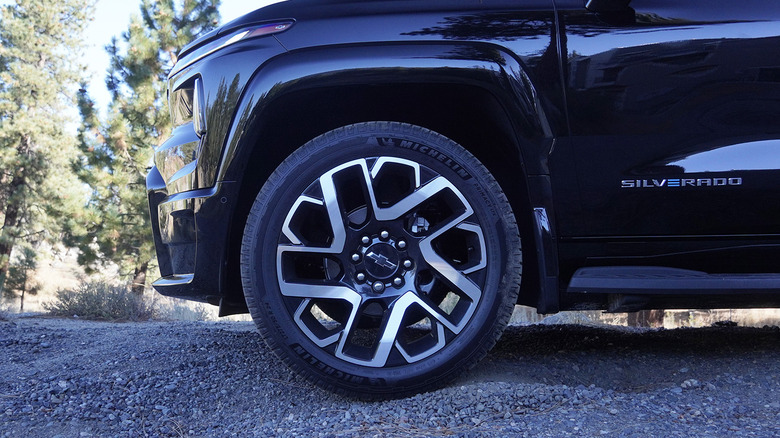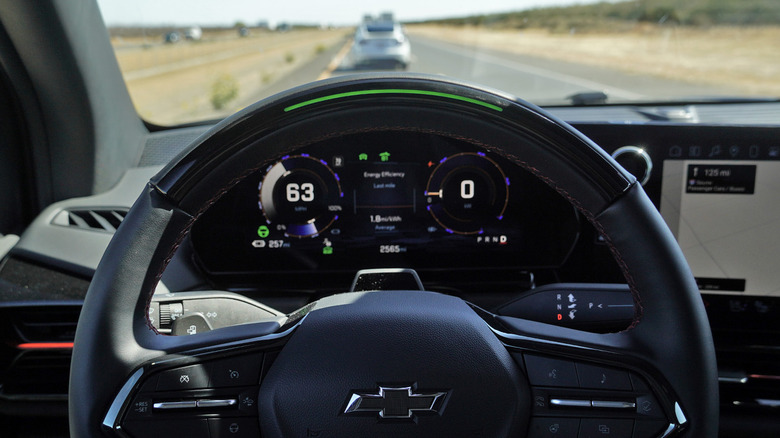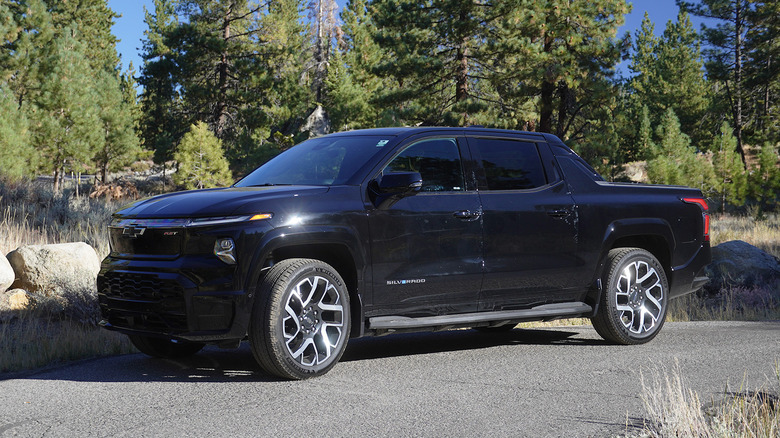2024 Chevrolet Silverado EV Review: Supercharger Access Changes The Equation
- The most legit real-world range of any electric truck
- Tesla Supercharger access is a huge deal
- Lots of capability with a frunk, bed, and midgate
- Big and heavy, to the max
- No Apple CarPlay or Android Auto
- Pricing can creep into six figures easily
On first impression, the 2024 Chevrolet Silverado EV's launch in Detroit earlier this year left a lot on the table. The enormous new electric pickup debuted in a top-spec RST trim package that cost far more than predicted, featured the largest wheels ever on a production vehicle, and struggled over terrible Detroit roads that emphasized suspension dynamics for clunk reduction more than handling or performance.
More recently, Chevy wanted me to experience the Silverado EV over the course of a longer trip, in a location better suited to the characteristics of the truck with the largest estimated range figure on the market so far. And so, I scheduled a road trip and packed up my gear for an adventure from San Francisco to Lake Tahoe, then down the I-5 freeway to Los Angeles. The journey totaled just shy of 750 miles, with over 6,000 feet of elevation gain between San Fran and Tahoe in the first 200 miles alone.
Plus, I threw a mountain bike in the bed, my luggage in the frunk, and hustled along winding canyon roads—far smoother than the frost heaves of Michigan. But another, undoubtedly more important development unfolded between my stints with the Silverado EV, too, when Tesla finally opened up the company's Supercharger network to Chevy vehicles. And that single fact alone, I can now admit, entirely changes the game.
Adjusting back into Chevy life
After flying into SFO and plopping my bags, including MTB gear, into the front trunk, I needed to reacquaint with Chevy's EV software. Remember that General Motors decided not to allow for Apple CarPlay on electric vehicles, an indefensible oversight that I cannot believe continues without a natural correction (because, as I'll mention later, Chevy does listen). Luckily, Spotify let me connect my own profile in the native UI's app screen via a QR code quite quickly, a surprise given the music player's generally horrible user interface in my iPhone. I cued up Waze, also via the Silverado, and hit the road for the cruise up to Tahoe.
Quite literally, Super Cruise—still my favorite semi-autonomous driving software. I caught up on work calls over the course of a straight-ish shot through Sac Town, where Super Cruise only deactivated for a few miles due to road construction. Then I took back full control from the machines once the road began to angle upward into the lower Sierra Nevada mountain range.
A first climb out of the city
Speaking of range, I kept an eye on my battery the whole time. Waze showed a 200 mile drive route, and I picked up the truck with the battery showing 100% charge. With a 200-kilowatt-hour pack and a claimed estimate of 440 miles total, I figured that even with my AC and ventilated seats blasting, 200 miles and 6,000-feet of climbing should be fine. And yet ye olde range anxiety remains unavoidable.
I reached the shore of Lake Tahoe with 54% of battery charge spent, and 251 miles of estimated range subtracted from the truck's readout—not bad, especially given the amount of time I spent absolutely hustling around long bends trying to pass slow semis on the steady uphill grade. Here, the air suspension—a slightly smaller system than on the similar, but not identical, Hummer EV—provided an admirable glidepath for my sensitivities that even the 24-inch rims failed to ruin.
Electric trucks for doing truck stuff
Early the next morning, mountain bike now loaded up in the truck bed (using what Chevy would love me to note as an available accessory), the temps threatened to break into the 40s. Not terribly cold, given the altitude, but also not ideal for battery performance. Yet over the course of a 46 mile round trip to the trailhead and back, the Silverado EV used only 10% battery and 31 miles of predicted range to drive 46 miles of up-and-down hill country.
Part of me wanted to play with the nifty midgate, a la the Avalanche from which Chevy's design team clearly borrowed styling inspiration, but the opportunity never seemed ripe. I remember an engineer telling me that he camps with a tonneau cover on the bed, the midgate's seat portion folded down and the glass up, with his feet in the bed while his head stays in the cabin and the climate control roars all night because the battery is, simply put, so huge. Theoretically, a rooftop tent mounted on a rack above the tonneau cover allows for a little two-level house—very Tahoe, such California, full-time lake life.
Can a Silverado EV truly overland?
Still, even while lugging around 200 kilowatt-hours worth of battery, the idea of overlanding in an EV seems fairly silly to me. Even if slow-speed driving off-road should actually maximize electric range given the reduced need to battle aero the entire time. But if I actually tried out a camping trip in an EV, the Silverado simply demands consideration because—gasp!—Chevy heard the criticisms, from almost every single reviewer of the RST, about those 24-inch wheels. So now the RST can come with 22s, though sadly the truck on this trip lacked that update.
And really, California roads revealed that the air suspension can at least somewhat moderate the challenging dynamics of such enormous wheels. I believe that the WT package, available initially for commercial fleet buyers only, probably drives best with understated 18-inchers. Such a wide variance of wheel size comes courtesy of the tiny brake rotors that regen complements in a huge way. Funnily enough, I saw more than a few Silverado EV in WT spec that Caltrans apparently bought in bulk—good job, Chevy, go get that government money as close to the spigot as possible.
Blasting down the hill
The next day's drive down the spine of California—not the towering Sierras, but the I-5 freeway—probably presented the Silverado EV with a more realistic challenge, given the sheer distance from Tahoe to Los Angeles. I checked on Google Maps the night before, range anxiety already cropping up, and a total of 488 miles seemed sketchy to shoot for in one go, even given the 6,000-plus foot descent from Tahoe to start the day.
In fact, starting at Tahoe and going straight downhill on a 100% charge threatened to turn the Silverado EV's regen capabilities off anyway, so as not to pump the battery too full of electrons. But I wanted to try out the Tesla Supercharger system anyway, which so seriously transforms the prospect of buying an electric Chevrolet. To do so, I needed to use an adapter that Chevrolet sells (aftermarket options exist but will void the truck's warranty) to allow Tesla's NACS plug to mate with GM's CCS1 port. Plus, I also needed to download the Tesla app onto my phone, enter my specific vehicle information, and of course, a payment card—though Silverado EV owners can do so through the myChevrolet app.
Supercharger noob at work
This was actually my first time ever using a Supercharger, so I stopped to test that everything worked properly at a station in South Lake Tahoe before going too far. I figured that if I needed to find Electrify America stations at the last second, better to be able to plan in advance than get left scrambling with my range depleting.
At the South Lake Tahoe station, I pulled in and almost immediately, a Tesla owner ambled up with an air of skepticism. I showed him the adapter and he explained how to start charging via the app. First I plugged the cable into the adaptor, then both into the truck, and about three minutes later—voila!—those precious electrons started flowing.
I only wanted to top up a little (again, so as not to lose regen in the name of overall time efficiency) so I stayed hooked up for just 16 minutes, during which Tesla pumped 25.738 kilowatt-hours into the Silverado for a cost of $15.44 total. The charge rate only peaked at 167 kilowatts, I noted, well below what I've seen at Electrify America stations even in the middle of nowhere. A swirling suspicion starting to form in my brain that Elon Musk might throttle back non-Tesla owners. Not a surprise, perhaps, and an attempt to maintain at least some incentive to buy Tesla vehicles even if the company itself pivots toward more of a utility business model than an automaker. Because the ubiquity or prevalence of Supercharger infrastructure certainly sets Tesla lightyears ahead.
The maths start to math
I switched off the charging in the app, unplugged the cord and adaptor, and hit the road again with 405 miles of expected range showing on the gauges. My drive plan sort of waffled throughout the day. Should I hammer as fast as possible to get to the next charger, add a few kilowatt-hours, and keep running? Or try to hypermile and regen as much as possible, in the off chance that I might make the whole trip without stopping again?
Regen down the hill certainly helped, but by about halfway through the trip my mental math simply stopped making sense. I consoled myself by thinking the Silverado probably erred on the side of safety—aka not leaving me stranded—but when I started checking the Tesla app for stations down the road toward LA, the closer I looked, the busier the chargers got. The prospect of needing to wait for a charger to get up and over the Grapevine sounded quite silly, so in the end I stopped in Firebaugh at an almost entirely empty Supercharger lot and plugged in again.
This time around, I spent 15 minutes hooked up and added 37.536 kilowatt-hours, spending $22.52 in the process. As I waited, the missed business opportunities at EV charging stations truly boggled my mind. No convenience store to buy snacks or beverages, no fast food, no restrooms even. Then I started to worry what might happen if my phone lost signal or died, would I be able to start and stop charging? Presumably, StarLink solves one of those problems, and I should be able to charge a smartphone from the EV. But still... Something in the equation seems missing.
A bit of anxiety to round off the road trip
When my mental math began to make a bit more sense, I unplugged again. The estimated range now showed 287 miles and I needed to drive another 231 to get home. Super Cruise on, again music and climate control blasting, I followed Tesla after Tesla down the two-lane blacktop while only occasionally glancing down at my state of charge. But by about halfway up the Grapevine, the situation started to look precarious again. By Frazier Park, my range remaining showed less than the distance to home.
Hours into the drive, I rued the thought of needing to battle LA traffic to find another Supercharger, plus the 4,700 descent from the top of the hill into town gave me hope. Sure enough, the grade almost doubled my numbers, as the range increased thanks to regen even as the Silverado gobbled up downhill miles. I finally arrived home with 6% battery and 30 miles of range still showing. Not bad, and plenty to tool around LA the next day to find another Supercharger, the nearest of which I learned is about two miles from my apartment.
2024 Chevrolet Silverado EV Verdict
In total, I used the equivalent of 107% of battery capacity to travel 488 miles, up and down long hills, mostly at top speed while staying as comfortable as possible. That translates to far better than the EPA-estimated 440 miles of range for the Silverado EV, which confirmed my suspicion that this truck and this truck only could have made the trip so seamless. It was borderline, even, to get home in one charge if I topped up to 100% from Tahoe and hypermiled at slower speed with the AC turned down.
I still harbor doubts about the actual size of the Silverado EV, in terms of precious metals mined, accident avoidance, and tire wear. Most people don't need 440 (or more!) miles of range, anyway. But the whole point, for Chevy and any other EV manufacturer, is that I could hop into this truck and just drive without changing my lifestyle. Or, at least, while making the least amount of a conscious shift as possible to attract the average person not accustomed to EVs quite yet.
Pricing-wise, I also still want to see mid-tier trims and drive the WT package, as well as the 22-inch wheels. But for now, until Rivian steps up in range or Scout actually delivers a truck, Ram and Ford look to my eyes on the back foot, making the Silverado EV almost a market of one. Other than the GMC Sierra EV, that is, which debuts for 2025 with identical specs and a touch more luxury but also a slightly steeper starting price tag.
